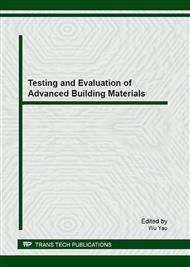[1]
Zhang Qian, Song Liang, Li Jiahe: Natural Science Journal of Harbin Normal University. Vol. 17(2001), p.8.
Google Scholar
[2]
Escalante Garcia J I: Cem Concr Res. Vol. 33(2003), p.1883.
Google Scholar
[3]
L.J. Parrot, M. Geiker, W.A. Gutteridge Dkilloh: Cem Concr Res. Vol. 20(1990), p.919.
Google Scholar
[4]
Mounanga P, Khelidj A, Baroghel Bouny A: Cem Concr Res. Vol. 34(2004), p.255.
Google Scholar
[5]
J.I. Escalante Garcia, J.H. Sharp: Cem Concr Res. Vol. 28(1998), p.1259.
Google Scholar
[6]
Ekaputri JJ, Ishida T, Maekawa K: Autogeneous shrinkage of mortars made with different types of sag cement. Presented at JCI Annual Convention. (Saitama, Japan, 2010).
Google Scholar
[7]
American Concrete Institute: Report of ACI Committee 233R-03(Farmington Hills, Mich, USA, 2003).
Google Scholar
[8]
Kumar S, Kumar R, Bandopadhyay A, et al.: Cem Concr Comp. Vol. 30(2008), p.679.
Google Scholar
[9]
Escalante JI, Gomez LY, Johal KK, Mendoza G, et al.: Cem Concr Res. Vol. 31( 2001), p.1403.
Google Scholar
[10]
K. Luke, F.P. Glasser: Cem Concr Res. Vol. 17(1987), p.273.
Google Scholar
[11]
Hill J, Sharp JH: Cem Concr Comp. Vol. 24(2002), p.191.
Google Scholar
[12]
W. Chen H. J. H. Brouwers : J Mater Sci. Vol. 42(2007), p.444.
Google Scholar
[13]
J. Bensted, P. Barnes: Structure and Performance of Cements, 2nd edition( Chemical Industrial Press, Beijing, China, 2009), p.73.
Google Scholar
[14]
Xiao Yong Wang, Han Seung Lee, Ki Bong Park, et al. : Cem Concr Comp. Vol. 32(2010), p.468.
Google Scholar
[15]
Morten Daugaard Andersen, Hans J. Jakobsen, Jørgen Skibsted : Cem Concr Res. Vol. 34(2004), p.857.
Google Scholar
[16]
Jørgen Skibsted, Christopher Hall : Cem Concr Res. Vol. 38(2008), p.205.
Google Scholar
[17]
Richardson IG, Brough AR, Groves GW, et al.: Cem Concr Res. Vol. 24(1994), p.813.
Google Scholar
[18]
Shi C, Day Robert L: Cem Concr Res. Vol. 25(1995), p.1333.
Google Scholar
[19]
D. Kwak: Ph.D. Thesis (Tokyo Metropolitan University, Tokyo, Japan, 2004).
Google Scholar
[20]
Hamlin M. Jennings, Jeffrey J. Thomas, Julia S. Gevrenov, et al. : Cem Concr Res. Vol. 37(2007), p.329.
Google Scholar


